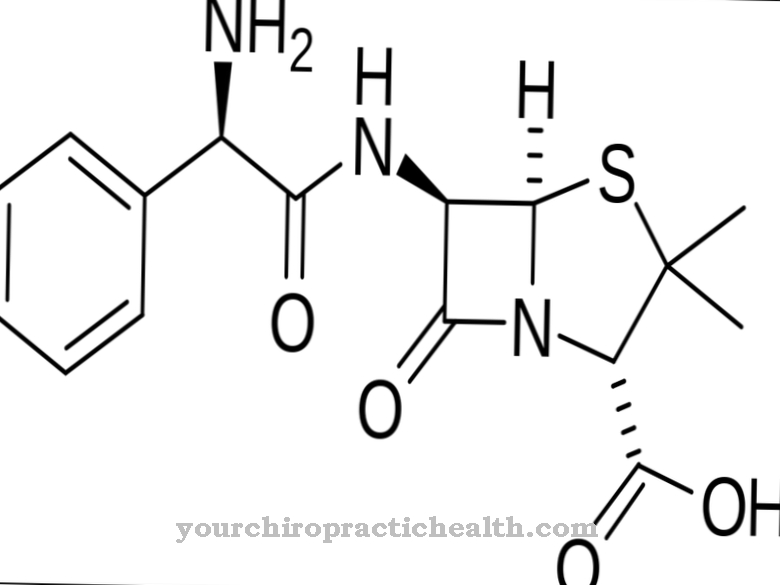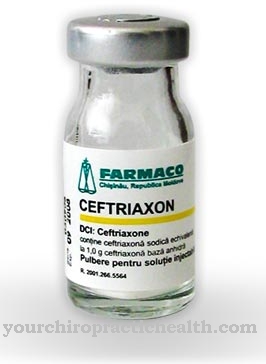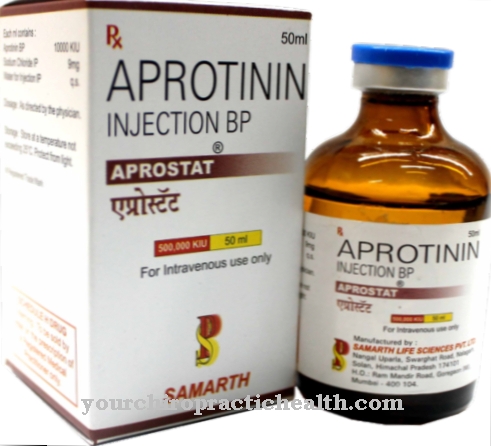Daunorubicin is a drug from the class of cytostatics and anthracyclines. The agent is used as a cytostatic agent.
What is Daunorubicin?

Daunorubicin is both a glycoside and an antibiotic. It comes from the group of anthracyclines. Anthracyclines are antibiotics that are used in chemotherapy as cytostatics against various malignant cancers.
The antibiotic daunorubicin is produced by the bacterial species Streptomyces peuceticus and Streptomyces coeruleorubidus. From a chemical point of view, the basic molecular structure of the drug consists of four benzene rings in a row. Accordingly, Daunorubicin belongs to the group of aromatic hydrocarbon compounds or to the aromatics.
Daunorubicin is in solid form at room temperature. The melting point is 208 ° Celsius, the solubility in water is poor. Daunorubicin requires a prescription and is used to treat various cancers. To do this, the drug is infused intravenously. Unlike some other cytotoxic drugs, daunorubicin is not used as an immunosuppressive drug in autoimmune diseases.
Pharmacological effect
Daunorubicin is a so-called DNA intercalator. The planar structure of the drug causes intercalation in the nucleobases of DNA. The term intercalation describes the reversible storage of atoms, molecules, ions or other chemical compounds in the DNA. In the case of daunorubicin, the drug is embedded in the DNA. The process of intercalation disrupts the replication of the DNA. The transcription of DNA is also impaired.
If replication is disturbed, mitosis cannot take place. In mitosis, the nucleus divides and the DNA is divided. Without mitosis, no cell division can take place or the cells that arise in a disturbed mitosis die the programmed cell death (apoptosis). Because cancer cells divide particularly often and particularly quickly, they are most affected by drugs that affect mitosis. However, many of the side effects arise because the cells of the body as a whole are stunted in growth by drugs of this type.
In addition to replication and transcription, RNA synthesis with the formation of polypeptides is also affected by the effects of daunorubicin. Daunorubicin also has an inhibitory effect on topoisomerase II. This enzyme also plays an important role in cell division.
Daunorubicin, however, has a third mechanism of action. After daunorubicin is absorbed, the drug is activated. In a redox reaction, an intermediate product is created that has a similar effect to free radicals. It transfers electrons to molecular oxygen. This in turn is converted into hydroxyl and superoxide radicals. Both forms of radicals have a cytotoxic effect. They damage the DNA and thereby preferentially the strand breaks of the DNA.
Medical application & use
Daunorubicin is a cytostatic drug that is used to treat malignant cancers. In adults, the drug is used in the treatment of acute myeloid and acute lymphoblastic leukemia. In acute myeloid leukemia (AML), the blood-forming system is affected. There is a massive increase in the immature precursors of the blood cells in the bone marrow. In acute lymphocytic leukemia (ALL), the precursor cells of the lymphocytes degenerate.
The therapy of the two forms of leukemia almost always takes place in combination with other cytostatic drugs. Daunorubicin is also used in children for the treatment of acute myeloid leukemia and for the treatment of acute lymphoblastic leukemia. Daunorubicin is also combined with other cytostatics here. In acute lymphoblastic leukemia, daunorubicin is administered in the so-called induction phase, i.e. at the beginning of treatment.
Risks & side effects
The side effects of daunorubicin are based on its cytotoxic and growth-inhibiting effects. In general, the tissues that have a high rate of cell division and / or growth are particularly affected. These include, for example, the mucous membranes, hair and bone marrow. In the gastrointestinal tract, daunorubicin can damage the mucous membrane. The damage can be minor, but ulcers can also develop. This results in pain in the mouth or stomach area, depending on the location.
As a result of the damage to the mucous membrane, nausea can also develop. Sometimes the patients have to vomit several times a day. This is due, on the one hand, to the damage to the mucous membrane and, on the other hand, directly to daunorubicin. The damage to the mucous membrane can be so severe that the bowel function is impaired. This can lead to diarrhea that requires treatment.
Daunorubicin also damages blood formation in the bone marrow. This creates a lack of leukocytes (leukopenia), thrombocytes (thrombopenia) and erythrocytes (anemia). The low point of blood formation is reached eight to ten days after the daunorubicin administration. The hematopoietic system has usually recovered about three weeks after administration.
As a result of the lack of white blood cells, infections occur more frequently during and after therapy with daunorubicin. These are mainly infections with bacteria and fungi. These can be life threatening. Thrombopenia increases the risk of bleeding in the patient.
A typical side effect of daunorubicin therapy is hair loss. Hair growth can come to a standstill or complete hair loss. This side effect of daunorubicin is usually fully reversible.
On the other hand, the cardiotoxic effects of daunorubicin can cause irreversible damage. Acute cardiotoxicity results in arrhythmias, angina pectoris and inflammation of the heart muscle. The late type often only manifests itself weeks, months or years after the administration of daunorubicin. Patients develop pulmonary edema or heart failure. Cardiomyopathy can be so severe that a heart transplant becomes necessary.
Because of its serious side effects, daunorubicin must not be administered during pregnancy or while breastfeeding. Serious heart diseases are also contraindications.














.jpg)













